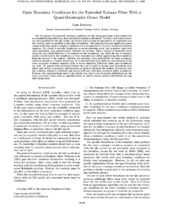Open Boundary Conditions for the Extended Kalman Filter With a Quasi-Geostrophic Ocean Model
Journal article

Åpne
Permanent lenke
https://hdl.handle.net/1956/3030Utgivelsesdato
1993-05-18Metadata
Vis full innførselSamlinger
Originalversjon
https://doi.org/10.1029/93jc01365Sammendrag
The formulation of consistent boundary conditions for the quasi-geostrophic (QG) model with an extended Kaiman filter in a data assimilation scheme is discussed. To form a well-posed boundary value problem for the QG model, the stream function must be specified at all boundaries and the vorticity must be specified at the inflow boundaries. The situation becomes significantly more complicated when proper boundary conditions are to be specified for the error covariance evolution equation. For closed or periodic boundaries no severe problems occur, but in general cases with open boundaries, only approximative methods can be used. Here a scheme is presented which allows for the stream function to be updated on the boundaries, e.g., from the use of measurements located close to the boundaries, or from meanders and eddies approaching the boundaries from the interior of the domain. Further, the boundary value problem for the error covariance evolution equation is treated extensively. It is demonstrated that numerical discretization of the error covariance evolution equation leads to severe numerical difficulties when open boundaries are used. An approximate numerical scheme that can be used to handle open boundaries with inflow and outflow is proposed, and examples are given to illustrate the method. Is is shown that the boundary scheme is consistent and can be used even with data located at inflow boundaries. However, the approximations used in the scheme may lead to loss of positive definiteness for the error covariance matrix and an algorithm must be used to ensure positive definiteness for long time integrations.